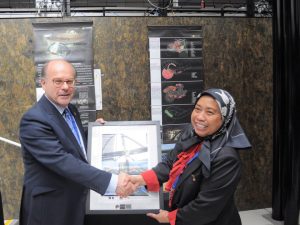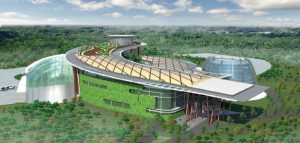On May 21, Dato’Hayati Ismail, the Malaysian High Commissioner to Canada, delivered a keynote addressed to the 6th International Association for the Advancement of Space Safety conference in Montreal. Here is the text of her speech.

IAASS President Tommaso Sgobba with Malaysian High Commissioner Dato’Hayati Ismail (Credits: Norul Ridzuan).
Malaysia is a progressive and fast developing country with a land area of 330,000 square kilometers, a population of 28 million; and new economies particularly those that are science and technology oriented are gaining popularity and recognition from both the people and the government. Space is one of the new economies that have received a lot of attention in recent times and with increasing visibility.
Malaysia started looking at space science seriously about two decades ago with the establishment of the Space Science Studies Division within the Ministry of Science, Technology and the Environment, in 1993. At that time, the focus was purely on space science education with activities centered at the planetarium in Kuala Lumpur.
Within a few years, the division became more than just an office for space science education when it ventured into satellite program management by designing, constructing, launching and operating a microsatellite called Tiungsat-1. (Tiung is the local name of a species of small bird very common in Malaysia known as the Common Myna). This satellite program was later spearheaded by a company fully owned by the Ministry of Science, Technology and the Environment, called Astronautics Technology Sdn. Bhd., and in September 2000, Tiungsat-1 was successfully launched into orbit.
In March 2001, the Space Science Studies Division came to be known as the National Space Agency and was chaired by Dato’ Seri Dr. Mahathir Mohamad, the then Prime Minister of Malaysia, signifying the official entry of the country and the Malaysian government into space ventures, chronicling Malaysia as among the first developing countries in the world to establish its own national space agency.
The Malaysian Space Agency later became a focus among the international space community, when it successfully sent the first Malaysian astronaut to the International Space Station in October 2007. Today, the Malaysian space agency is known as ANGKASA, a Malay translation from the word “space”, and it conducts various activities in the continuation of its satellite and astronaut programs, while maintaining its original role as a general space educator with its planetarium and astronomical observatory facilities.
Such achievements by the country has positioned Malaysia as a pioneer and front-runner in space ventures in the South East Asia region, and created a positive environment for non-governmental efforts in space ventures. The biggest non-governmental space venture in Malaysia is Spaceport Malaysia; an idea pioneered by a group of commercial space travel activists since 1999.
The vision of Spaceport Malaysia was first presented at the International Association for the Advancement of Space Safety at the 2nd IAASS Conference in Chicago in May 2007, and since then progress has been significant. It has received substantial cooperation and support from international partners, including major international aerospace manufacturers and space research organizations. Today, the Spaceport Malaysia project is well known amongst the international space community, including the IAASS and in particular, supporters of commercial space travel. Its objective is to provide safer and lower cost access to space.
Spaceport Malaysia today is a project under the attention of a dedicated government agency on aviation and space industry in Malaysia – the Malaysian Industry-Government Group for High Technology (MIGHT), which advises and monitors its progress to ensure the project is synchronized with the national development agenda.
Spaceport Malaysia has attracted a number of service partners including providers of commercial zero gravity flights, small satellite launches, and potential investors. The planned zero gravity flight service will be part of a complete zero gravity research and recreation facility, while the small satellite launch service will use an air launch system from conventional commercial airliners for economy and reliability.

SpaceportSEA (Spaceport at South East Asia), the new facility for commercial suborbital spaceflight that will be built in Malaysia (Credits: SpaceportSEA).
Several existing commercial airports in Malaysia have agreed to provide facilities to host the early operation of Spaceport Malaysia, forecasted next year before the real spaceport complex is ready in less than half a decade. These airports not only provide the basic facilities such as hangars and runways, but also land for supporting commercial activities.
Spaceport Malaysia will consist of both the traditional commercial space components and new property components. Besides a spaceflight terminal, an aviation and space university, satellite services facilities, space theme accommodations, space theme parks, manufacturing facilities and commercial facilities are planned for the spaceport. Within the spaceport project too, there are two suborbital vehicle development programs, where one with foreign partnership and the other a fully local venture. Both have received attention from potential investors. These suborbital vehicle programs also give unique strength and advantage to the Spaceport Malaysia project, as not all spaceport projects in the world include such a vehicle development program.
Being a project under the attendant of IAASS, Spaceport Malaysia embraces the Philosophy of Safety, which has been well integrated within the project, not only at the design stage, but also at the policy making stage, placing safety as the main agenda in the planning, designing, development and the operation of the spaceport and all its components including suborbital vehicles. As a major entry by Malaysia into international space ventures, Spaceport Malaysia will not compromise safety in its progress and development.
Green technology is also a main agenda where buildings and its occupants will smartly interact with the environment and use natural resources. Electric vehicles will be used extensively at the spaceport and to encourage this, public facilities and private residences will be equipped with light electric vehicles and charging facilities.
Another major agenda is Strategic Globalization. Spaceport Malaysia plans to play a significant role in globalization and internationalization in the future. Activities of this agenda will be strategic cooperation with particular spaceports and the promotion of point-to-point inter-continental suborbital spaceflights.
The Malaysian High Commission in Canada wishes to thank the IAASS for its support of Spaceport Malaysia and opportunities given to the project and welcomes international recognition such as from the IAASS, which will be significant for international promotion and marketing of the spaceport.
As part of Malaysia’s Economic Transformation Programme, the Government of Malaysia is committed to ensure continued support for the advent and development of new space and high technology industries, which will catapult Malaysia as a developed country by 2020. The synergy between governmental and non-governmental efforts, particularly in this field is crucial and we believe that the globalization of the space industry is a very significant aspect that will make up the new global economy.
On a related note, I would like to congratulate Canada on the successful space mission by Commander Chris Hadfield. He has brought space closer to the ordinary person on the ground.
Thank you.
Her Excellency Dato’ Hayati Ismail
Malaysian High Commissioner to Canada

















































































































![A trajectory analysis that used a computational fluid dynamics approach to determine the likely position and velocity histories of the foam (Credits: NASA Ref [1] p61).](http://www.spacesafetymagazine.com/wp-content/uploads/2014/05/fluid-dynamics-trajectory-analysis-50x50.jpg)



Leave a Reply